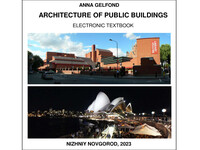Architecture of public buildings : an electronic textbook for university students
Покупка
Издательство:
ННГАСУ
Автор:
Гельфонд Анна Лазаревна
Год издания: 2023
Кол-во страниц: 1150
Дополнительно
Вид издания:
Учебное пособие
Уровень образования:
ВО - Бакалавриат
ISBN: 978-5-528-00499-0
Артикул: 832645.01.99
The electronic textbook is based on An illustrated course in The discipline «Architecture of Public Buildings». It is intended for students of educational institutions of higher education studying in the field of training «Architecture».
All rights reserved. Copying and public reproduction are prosecuted by law.
Скопировать запись
Фрагмент текстового слоя документа размещен для индексирующих роботов
Ministry of Science and Higher Education of the Russian Federation Federal State Budgetary Educational Institution of Higher Education «Nizhny Novgorod State University of Architecture and Civil Engineering» A. L. Gelfond Architecture of public buildings Nizhny Novgorod NNGASU 2023
ББК 85.11
Г 32
Reviewer:
M. M. Gavrilova - Academician of the RAASN, Professor of the MARKHI, Director of the architectural bureau "Association of Theater Architects"
Gelfond A. L. Architecture of public buildings: an electronic textbook for university students / A. L. Gelfond; responsible editor E.A. Aleshugina. - Nizhny Novgorod state university of architecture and civil engineering - Nizhny Novgorod: NNGASU, 2023. -1150 p. (15 x20) -35.9 usl. p.l. : ill. ISBN 978-5-528-00499-0
The electronic textbook is based on An illustrated course in The discipline «Architecture of Public Buildings». It is intended for students of educational institutions of higher education studying in the field of training «Architecture».
All rights reserved. Copying and public reproduction are prosecuted by law.
ISBN 978-5-528-00499-0
© A. L. Gelfond © NNGASU, 2023
LECTURE 1. GROUPS OF PUBLIC BUILDINGS. THE MAIN FACTORS THAT TYPOLOGICAL FEATURES OF PUBLIC BUILDINGS LECTURE 2. FUNCTIONAL, PLANNING, COMPOSITIONAL AND STRUCTURAL SCHEMES OF BUILDINGS LECTURE 3. STRUCTURAL UNITS OF BUILDINGS. MAIN PLANNING ELEMENTS OF BUILDINGS LECTURE 4. HORIZONTAL AND VERTICAL COMMUNICATIONS LECTURE 5. FIRE SAFETY REQUIREMENTS. ESCAPE ROUTES LECTURE 6. SCHOOL BUILDINGS LECTURE 7. BUILDINGS OF HOSPITALS LECTURE 8. TRADE AND CATERING BUILDINGS LECTURE 9. RAILWAY STATIONS LECTURE 10. BUILDINGS AND STRUCTURES FOR PHYSICAL EDUCATION AND SPORTS LECTURE 11. MUSEUM AND EXHIBITION BUILDINGS LECTURE 12. SPECTACULAR BUILDINGS LECTURE 13. HOTELS LECTURE 14. BUILDINGS AND COMPLEXES OF BANKS LECTURE 15. PARKING LOTS LECTURE 16. MULTIFUNCTIONAL BUILDINGS AND COMPLEXES. BUILDINGS OF BUSINESS CENTERS."END-TO-END" ARCHITECTURAL TYPOLOGY OF PUBLIC BUILDING LECTURE 17. ARCHITECTURE OF TEMPORARY BUILDINGS LECTURE 18. ARCHITECTURAL DESIGN OF PUBLIC BUILDINGS TAKING INTO CONSIDERATION THE NEEDS OF THE DISABLED AND LOW-MOBILITY GROUPS LECTURE 19. TECHNICAL AND ECONOMIC ASSESSMENT OF PROJECT SOLUTIONS OF PUBLIC BUILDING. TECHNICAL AND ECONOMICAL INDICATORS
The architecture of public buildings plays a responsible role in shaping the integral spatial environment of cities and settlements. New concepts of habitat organization and the development of new standards of life quality require study of buildings and territories interaction. We must create conditions for the formation of a harmonious aesthetically valuable architectural environment. The design of buildings and public spaces should focus on solving the problems now facing the world of architectural community: ■ preserving historical and cultural traditions; ■ consideration of natural and environmental factors; ■ balance of local (regional) and universal (global) qualities when forming the architectural image of buildings or spaces; ■ defining the development of new technologies; ■ formation of socio-public and individual-personal architectural environment; ■ creating an architectural environment that is accessible to people with low mobility.
When forming an integral architectural environment of cities and settlements, it is necessary to pay attention to the balanced architectural and compositional unity of all its components: functional saturation of territories; development of all types of communications - engineering, transport, pedestrian; improvement of the public service system; formation of current types of residential, public, religious, industrial buildings and structures; as well as protection and adaptation for modern use of cultural heritage objects. Based on a system of criteria (social; urban planning; architectural and typological; environmental) assessment of the existing structures of the public service system should be made, the degree of their suitability for modern use should be made. When developing a strategy for the effective development of the network of service facilities, it is necessary to provide for: ■ multifunctionality and multidisciplinary use; ■ modularity and mobility, the use of fast built objects of the service system; ■ creating a barrier-free environment and universal design for people with low mobility; ■ architectural and compositional unity, balance of the public service system.
LECTURE 1 GROUPS OF PUBLIC BUILDINGS. THE MAIN FACTORS THAT FORM THE TYPOLOGICAL FEATURES OF PUBLIC BUILDINGS List of the main functional and typological groups of public buildings: A. Buildings for public service facilities: 1. Buildings for educational goals. 2. Social services and Hospital Buildings. 3. Public service buildings. 4. Buildings for cultural and leisure activities. 5. Buildings for temporary stay. B. Buildings of public and State service facilities: 1. Administrative buildings. 2. Special management buildings.
BUILDINGS FOR EDUCATIONAL GOALS:
1.1 Educational institutions:
- pre-schools;
- general education institutions (schools, gymnasiums, lyceums, colleges, boarding schools, etc.);
- institutions of professional education: primary, secondary, university.
1.2 Extracurricular institutions for schoolchildren and young people.
1.3 Special institutions: clubs, driving schools, additional schools, etc.
PRE-SCHOOLS f* I* Ф ?
SCHOOLS
UNIVERSITY


